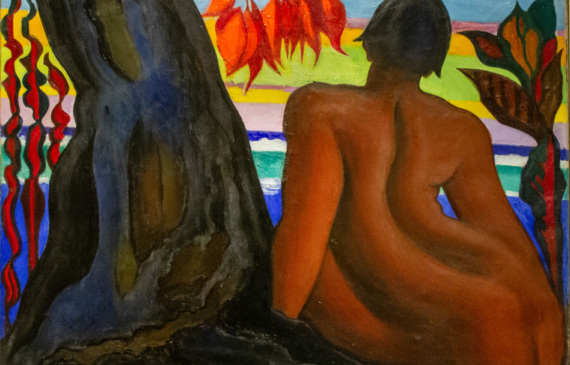
Joseph Stella
Italian-American, 1877-1946
Tropicalia, 1940
Oil on canvas
25 ¾ H. x 35 ¾ W. inches
Signed lower left: Joseph Stella/1940
Joseph Stella immigrated to New York from a small village outside of Naples, Italy, in 1896. He initially came to the United States to study medicine, but abandoned that pursuit to become an artist. Stella enrolled first at the Art Students League and later began his studies under William Merritt Chase, a renowned painter celebrated for his portraiture. The young immigrant worked in a more realist style influenced by both Chase and Robert Henri, the Ashcan school artist under whom Stella also studied in the first years of the 1900s.
In 1909, he returned to his home country of Italy for an extended stay, followed by a foray to Paris where he would meet visionary artists of the time like Pablo Picasso, Gino Severini, Umberto Boccioni, and Henri Matisse. These encounters challenged his relationship with realism, as Modernism was an art of the present, while realism clung to the past. Upon returning to New York in 1912, he began his first major Futurist work of Coney Island, which would serve as a turning point for the artist and his skillful amalgamation of deconstructed styles.
By 1920, his painting style had moved away from traditional, representational compositions in favor of Modernism, as he was fostering his unique blend of Futurist and Cubist concepts. In the late 1930s, Stella traveled to Barbados and dubbed it “The Magic Island.” He took sketches of the people and flora he encountered, using these in combination with his memory to execute late paintings of the tropical paradise. Stella’s approach to painting varied greatly during the later part of his career, moving between realism, abstraction, and surrealism. His experience in Barbados with its rich ecosystems renewed his creative spirit; the artist himself said that his “…drowsing energy, tortured by the cold of northern countries, was reawakened as if by magic, set aglow by the radiance of gold and purple light. All the ardor of youth surged through me, with the overflowing, stinging, demanding desire for new conquests in the virgin lands of art.”